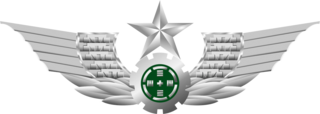
The Kuwait Armed Forces are the military forces of the State of Kuwait. They consist of the Kuwait Air Force, the Kuwait Army, the Kuwait Navy & the Kuwait National Guard. The governing bodies are the Kuwait Ministry of Defense, the Kuwait Ministry of Interior, and the Kuwait Fire Service Directorate. The Emir of Kuwait is the commander-in-chief of all defense forces while the Crown Prince is the deputy commander.
A division is a large military unit or formation, usually consisting of between 6,000 and 25,000 soldiers. In most armies, a division is composed of several regiments or brigades; in turn, several divisions typically make up a corps.

A battalion is a military unit, typically consisting of 300 to 1,000 soldiers commanded by a lieutenant colonel, and subdivided into a number of companies. The typical battalion is built from three operational companies, one weapons company and one HQ company. In some countries, battalions are exclusively infantry, while in others battalions are unit-level organisations.

Operation Compass was the first large British military operation of the Western Desert Campaign (1940–1943) during the Second World War. British, Empire and Commonwealth forces attacked Italian forces of the 10th Army in western Egypt and Cyrenaica, the eastern province of Libya, from December 1940 to February 1941.
The Saudi Arabian National Guard or SANG, also known as the "White Army", is one of the three major branches of the military forces of the Kingdom of Saudi Arabia.

The People's Liberation Army Ground Force is the land-based service branch of the People's Liberation Army and the largest and oldest branch of the entire Chinese armed forces. The PLAGF can trace its lineage from 1927 as the Chinese Red Army; however, it was not officially established until 1948.

The Type 74 is a main battle tank (MBT) of the Japan Ground Self-Defense Force (JGSDF). It was built by Mitsubishi Heavy Industries as a supplement to the earlier Type 61. It was based on the best features of a number of contemporary designs, placing it in the same class as the US M60 Patton or German Leopard 1. Like these designs, it mounts the M68 rifled 105 mm gun. The design did not enter widespread use until 1980, by which point other Western forces had introduced more capable designs.

The Battle of Medina Ridge was a tank battle fought on the 27 February 1991, during the Gulf War, between the U.S. 1st Armored Division and the 2nd Brigade of the Iraqi Republican Guard Medina Luminous Division outside Basra, Iraq. The U.S. 3rd Brigade, 3rd Infantry Division, was also a major contributor, by leading the attack. Iraq's Adnan Motorized Division was also a participant. Medina Ridge is the name American troops gave to a low rise, approximately seven miles (11 km) long.

The Battle of Norfolk was a tank battle fought on February 27, 1991, during the Persian Gulf War, between armored forces of the United States and United Kingdom, and those of the Iraqi Republican Guard in the Muthanna Province of southern Iraq. The primary participants were the U.S. 2nd Armored Division (Forward), 1st Infantry Division (Mechanized), and the Iraqi 18th Mechanized and 9th Armoured Brigades of the Republican Guard Tawakalna Mechanized Infantry Division along with elements from eleven other Iraqi divisions. The 2nd Armored Division(Fwd) was assigned to the American 1st Infantry Division as its 3rd maneuver brigade due to the fact that one of its brigades was not deployed. The 2nd Armored Division(Fwd)'s Task Force 1-41 Infantry would be the spearhead of VII Corps. The British 1st Armoured division was responsible for protecting the right flank of VII Corps, their main adversary being the Iraqi 52nd Armored Division and multiple infantry divisions. It was the final battle of the war before the unilateral ceasefire took effect.

The Royal Jordanian Army is the ground force branch of the Jordanian Armed Forces (JAF). It draws its origins from units such as the Arab Legion, formed in the British Mandate of Transjordan in the 1920s. It has seen combat against Israel in 1948, 1956, 1967, and 1973. The Army also fought the Syrians and the PLO during Black September in 1970.
A Marine expeditionary brigade (MEB) is a formation of the United States Marine Corps, a Marine air-ground task force of approximately 14,500 Marines and sailors constructed around a reinforced infantry regiment, a composite Marine aircraft group, a combat logistics regiment and a MEB command group. The MEB, commanded by a general officer (usually a brigadier general), is task-organized to meet the requirements of a specific situation. It can function as part of a joint task force, as the lead echelon of the Marine expeditionary force (MEF), or alone. It varies in size and composition, and is larger than a Marine expeditionary unit (MEU) but smaller than a MEF. The MEB is capable of conducting missions across the full range of military operations.
The Balkan Front was a military formation of the Bulgarian People's Army, intended for wartime use under the general direction of the Soviet General Staff. If a war was to have broken out between NATO and the Warsaw Pact, the bulk of the Bulgarian army would have been assigned to it.

Operation Vantage was a British military operation in 1961 to support the newly independent state of Kuwait against territorial claims by its neighbour, Iraq. The UK reacted to a call for protection from Sheikh Abdullah III Al-Salim Al-Sabah of Kuwait, and air, sea and land forces were in place within days. Iraq did not attack and the British forces were replaced by the Arab League. Iraq recognised Kuwaiti independence in 1963.

Sheikh Saad Al-Abdullah Al-Salim Al-Sabah was the Emir of Kuwait from 15 January until his abdication on 24 January 2006, succeeding Sheikh Jaber Al-Ahmad Al-Jaber Al-Sabah.

The Kuwait Police is an agency of the Ministry of Interior of Kuwait, which maintains the national security envelope, defense of land border, coastal and the rule of law in the State of Kuwait. The Kuwait Police Agency was established in 1938 by Ahmad Al-Jaber Al-Sabah as the Directorate of Public Security Force.
The Kuwait 25th Commando Brigade of the Kuwait Army, commonly known as the 25th Commando, is one of Kuwait's various principal Commando brigades. The 25th Commando operates at the disposition of the respective commander who reports to the respective leadership of the Military of Kuwait; executing, participating, supporting, and carrying all conflicts in which the Military of Kuwait engaged since inception in 1960. The 25th Commando executes general operations in support of the Military of Kuwait.
Sheikh Mubarak Abdullah Al-Jaber Al-Sabah was a member of the House of Sabah and one of the first Kuwaitis to attain the military rank of lieutenant general. He was one of the first Kuwaitis to be commissioned as an officer by the Royal Military Academy Sandhurst, UK, and the first Kuwaiti to receive an Amiri Decree for appointment as Chief of the General Staff. Mubarak initiated joint training of Kuwait Armed Forces and United States Armed Forces in 1977 and, the following year, was the first military officer to establish conscription.

The Battle of Kuwait International Airport occurred on February 27, 1991, during the 1st Gulf War. It was a tank battle between the United States and Iraq. Despite being a very large battle it is often overlooked compared to the other battles which took place during the war. No less than elements of 18 divisions total participated in this battle. U.S. Army Special Forces units and multiple Iraqi Commando units were also in theatre. In reality the battle took place over a span of three days despite the primary battle at Kuwait International Airport lasting only one day. Much of the combat actually took place en route to the airport. The battle featured the "Reveille Engagement" which went on to become the biggest and fastest tank battle in United States Marine Corps' entire history.

The General Staff H.Q. of the Kuwait Army redesignated in 1953 following formation in 1949, is a management department of the Kuwait Armed Forces, the national military of the State of Kuwait. The Chief of the General Staff is the senior combat military officer governing doctrines of the Kuwait Army, the Kuwait Air Force and the Kuwait Naval Force, but excludes the Kuwait National Guard, the Kuwait Police and Kuwait Fire Service Directorate. He is appointed by the Kuwait Defense Minister, a deputy prime minister, who is appointed by the Prime Minister of Kuwait; the latter appointed by the Emir of Kuwait, the Commander-in-chief of the Military of Kuwait.

Following the deterring effect of Operation Vantage (1961), Kuwait gained its recognition by Iraq in 1963. Both countries had ongoing border disputes throughout most of the 1960s, although often resolved and restrained within the history of Arab solidarity.














